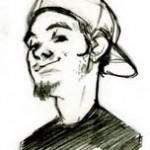[Justin Mullens, the man behind the fine, fine music in Boss Rush, has graciously offered write down some of the thoughts he had while he was composing. For anyone interested in how the music came to be, it’s a fun read, and offers a fascinating glimpse into what his creative process looks like. He clearly knows what he is talking about, since he specifically calls out the Moon Level music from Duck Tales. 🙂 -Montoli]
First of all, a little personal background: I loved shooters when I was growing up. I was addicted ever since I first laid my hands on Defender in the arcades, I got really into them with Gradius and R-Type on the NES & SNES, and was completely hooked when Square released Einheinder on the Playstation. There was a ton of shmups I didn’t play, but the ones I did play left an indelible impression. It was around this time that I first started making electronic music using Impulse Tracker in DOS, which is basically the origin of my career as a sound designer in the video games industry. Even though shooters and tracker music were two of my loves growing up I’ve never had a chance to work on a “classic style” 2D shooter before now, and I was really excited by the opportunity to work with Chris (Paper Dino) when he asked me to do the music and sound effects on Boss Rush.
That being said, I didn’t really do any research before starting to write the music for Boss Rush, I just pretty much let it flow out of me based on the feelings I remember having as a kid when I played these kinds of games. I started off by writing 2 or 3 songs as “sketches” to get my bearings, and once I finished those I knew where I wanted, and more importantly, didn’t want to go with the final tracks.
The main thing I realized was that I didn’t want to make “chip-tune” music. Been there, done that. Plus the fact that it’s so en-vogue right now makes me really want to stay away from that side of things. Instead, what I realized that I really loved and wanted to capture about those old songs was the grittiness and energy that they exude. I mean, even Ducktales on the NES was RAW! (Moon level!!!) My goal became to achieve that same gritty feeling while using an instrument palette that combined distorted synths with distorted traditional instruments. This led me to some unexpected instrumentation for main parts like a church organ & pan flute (used in Upward Spin) or a glockenspiel (used in Colossal Terend).
The other thing I loved about those old songs was the ultra obvious melody line, and underneath that, harmonies and rhythms that created the perfect atmosphere. The music in these games was NOT background/ambient music, but it did a great job of giving a mood to the experience that put me into the right space (literally).
Step 1: Grittiness – check. Step 2: Obvious melody, maintain ambiance – check.
Anytime I write music that accompanies visuals my main concern is to tie the feeling of the songs so strongly to the imagery that the player feels like it is all one contiguous thing that was forged from the same fire. If it doesn’t feel like that, then I have failed. The next step after sketching some ideas and determining the direction I want to go in is to sit down in front of the game and let it tell me what the music should sound like. As soon as I get a playable version of the game I will run through each level 20-50 times and just see what ideas come to me. I normally like to start off with just a portable recorder and my voice. I’ll hum some melodies and rhythms completely free-form as I play through the game. I use these snippets later on if I need to, but sometimes I don’t use them at all – I really just like the process of getting some music happening in my head first before I sit down in front of my keyboard (plus I’m playing the game, which makes it pretty hard to play my midi keyboard at the same time).
Next, I’ll capture some videos of the most inspiring and important parts of the game, loop those up, and start hammering away on my keyboard while I watch them. Almost everything is written really quickly while I watch these videos. I tend to spend less than an hour writing each peace of music initially, and then I’ll spend anywhere from a few days to a few weeks tweaking them and getting them just how I want them. I design the music to help make the visuals pop, and I spend most of my time adjusting instruments and song arrangements to get that happening. The music should reach a state where it is emphasizing all aspects of the game, which will in turn make the music stronger as well. Also, it’s very important to make the music NOT ANNOYING.
As for my tools, I used Logic 8 to write everything in Boss Rush. The ES1 was my main instrument, followed by the ES2 and Sculpture. All drums were done in the EXS24. For plug-ins I used Dist II, Bit Crusher, Guitar Amp, and a ton of Tape Delay and reverb to add spaciousness.
All in all, I had a really awesome time creating the audio for Boss Rush. This was my very first attempt at this genre, and I loved it. I can’t wait to work on more shooters in the future!
Check out the mp3‘s that are available on PaperDino.com, all comments and feedback are appreciated. Please, let me know what you think
Justin Mullens – Sound Designer
